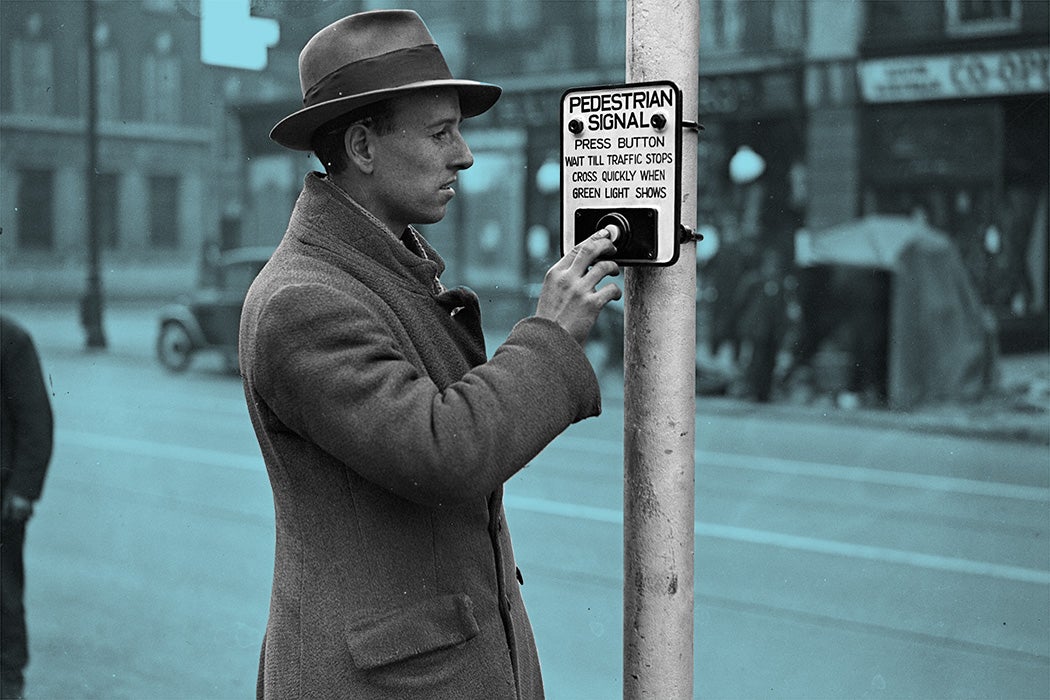Crossing a road is something many of us do every day. But how, and where, we cross is based on a matrix of legal and cultural understandings. As historian Joe Moran explores in his history of road crossings in Britain, the development of rules was balanced against the civil liberties of the pedestrian.
“Governments have often appealed to good sense and civic duty rather than the threat of punishment, in response to public fears about the excessive coercion of pedestrians or motorists,” he writes. “One consequence is that there are few legal constraints on walking across the road in Britain—unlike large parts of North America and western Europe, where red lights and ‘don’t walk’ signs are legally binding, and there are fines for jaywalkers.”
In the UK, crossing against the lights or walking into traffic may be foolish, but it’s not illegal.
“The relatively informal law and etiquette of crossing roads in this country is a product of the complex history and fraught politics of motor transport, road safety, and urban design,” Moran explains.
The informality became an issue with the arrival of the automobile in the early twentieth century. An increasing number of cars on the road in the interwar period meant more accidents between vehicles and pedestrians, and this was a challenge that needed to be addressed.
As Moran writes, “A particular concern was the death of children, 14,000 of whom were killed on the roads between 1927 and 1937.” (To put that appalling figure in context, there were 54 children killed on Britain’s roads in 2022.)
The 1930s became a period of experimentation with road design, through marked crossings points and signals, to accommodate pedestrians safely. According to Moran, the the London County Council “experimented in 1934 with kerbside posts with a ‘C’ sign, and ‘checkon’ crossings, so named because they were made up of small black-and-white squares but were also ‘a check on accidents, mortality, recklessness, jay walking.’”
However, there was confusion among road users (by car and by foot) on the meaning of the signs. These road markings were not standardized, and they became part of the visual noise of the cityscape. “Belisha Beacons”—yellow circular lights at the top of poles—were also used to mark pedestrian crossing points in the 1930s, but there remained a lack of clarity as to whether vehicles or pedestrians had right of way.
As well as adjusting the infrastructure, an important element of road safety was education. Safety campaigns for children included police presentations at schools and teaching children songs to remind them to look both ways. But even this had its critics, who thought it all seemed like “indoctrination,” with too much of a whiff of the Third Reich.
These concerns evaporated with World War II. Not only did roads become more dangerous (due to enforced blackouts), but a militaristic vibe in lessons for children was more widely encouraged. One popular drill: “At the kerb, halt! Look right, look left, look right again. If all clear, quick march!”
After the war, pedestrian markings were formalized, with the introduction of the stripes that are still used today (and spread to other nations).
“A thousand sets of black-and-white stripes were painted on roads in preparation for ‘pedestrian crossing week,’” writes Moran, which was held in April 1949 “not only to test the new zebras but also to promote more widespread observance of crossings generally.”
But the government still didn’t go so far as to penalize jaywalking. The freedom of the King’s Highway applies to those on foot as well as behind the wheel. Using crossings was to be encouraged, but not enforced.
Weekly Newsletter
Meanwhile, the Royal Society for the Prevention of Accidents amped up safety education for children, through their squirrel mascot “Tufty”. Tufty taught children how to cross the road, and Tufty Clubs (local road safety groups) were set up across the country. By the 1970s, the clubs had 2 million members.
A squirrel might seem an odd choice, but cute animal names are an intriguing feature of British crossing culture. The zebra crossing format was followed by the short-lived “panda” (the first electronic system with a button for pedestrians). The Pelican and Puffin (which differ in whether the red/green walking figures are displayed above the road or on the pedestrian push-button unit) followed soon after and became familiar features in Britain’s cities. There are also Toucan crossings (for “two can”), offering shared cyclist and pedestrian use, and the rarer Pegasus which has signals for equestrians.
Today, the crossing where we press a button and wait for the signal is part of the background of city life; it’s not something most of us even think about. As Moran explains,
The high-tech nature of contemporary pedestrian crossings means that they are, to use a term from actor network theory, “black-boxed.” In other words, they seem like an automatic, intrinsic part of daily life, disconnected from historical contexts and debates.
But they exist as part of a long-term problem-solving process for sharing the roads and balancing human needs with new technology.







